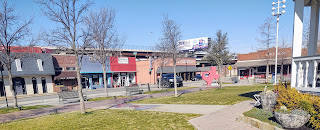History of two Dallas suburbs
In my last blog post, I told you about my personal connection to Texas history through a set of fourth great-grandparents and third great-grandparents who are buried in areas of northeast Texas. (A way from the Dallas-Fort Worth metroplex.)
The towns of Gainesville and Bonham, where my third great-grandparents are buried, are so far from DFW they still seem remote to me. Gainesville, where Great-Great-Great-Grandpa Graham rests, is a town of less than 20,000 people about 80 miles north of downtown Dallas and 12 miles from the Oklahoma border. Bonham, where my Great-Great-Great Grandma is buried, is a city of just over 10,000. It’s also about 80 miles from downtown Dallas, but 65 miles east of Gainesville.
My fourth great-grandparents are buried in Pilot Point, a city a mere 55 miles from downtown Dallas. It’s even closer to my home in Richardson, Texas. Pilot Point is still too far north to be considered part of the Dallas Fort Worth metroplex. It’s also still a very small town, with less than 5,000 population.
As I have learned about these ancestors, I have wanted to visit Pilot Point and perhaps the more distant cities. I have only been able to go to Pilot Point once and didn’t have very long I could spend there then. Instead, I’ve been happy to learn about their era by visiting historical landmarks of the towns just north of Dallas.
I’m going to tell you about two of these in this blog post about two of those towns, Farmers’ Branch and Carrollton. Dallas extends 15 miles north of its downtown area. These towns, like my current hometown of Richardson, are adjacent to northern Dallas.
My fourth great-great-grandparents probably saw stores, churches and schools like the ones now on display at the Farmers Branch Historical Park, along with the various houses I've posted above. Great-Great-Great-Great Grandma Graham probably also saw train depots.
I imagine Farmers’ Branch and Carrollton were both nothing
more than bumps on the road if my fourth great-grandparents ever traveled from
Pilot Point down to Dallas. Farmers’ Branch is a city of about 35,000 people
now. Carrollton is a larger metropolis, home to about 130,000. But when my
fourth great-grandparents were alive, neither had much more than farms.
Farmers’ Branch was the headquarters of the Texas Land and
Immigration Company in those days. Even before my ancestors immigrated to Texas
from Tennessee in about 1856, this business had established Peters’ Colony in
the 1840s. It helped more than 2,000 families relocate to Texas from other
states between 1841 and 1848. Many of these settled in the towns now on
Dallas’s northern fringe, including Farmers’ Branch, Carrollton and The Colony.
But some were as far north as Wichita Falls (150 miles northwest of Dallas) and
some established themselves even further than downtown Dallas.
In its early days, the Texas Land and Immigration Company
had a contract with the Republic of Texas to bring in new residents. It gave
them land from which Native Americans had recently been forced away. The
families received 640-acre ranches, log cabins, rifles and ammunition.
It was still in business until 1925. So, it may have helped
my ancestors come there from Tennessee. However, there were others settling
into north-central Texas without the help of the Texas Land and Immigration
Company. I’m suspecting even if my ancestors had not done business with the
Texas Land and Immigration Company, they knew of this business.
Farmers’ Branch didn’t have much else until the mid-1870s.
It had a post office starting in 1848 when the Texas Land and Immigration
Company was in its heyday. At least one church, which also housed a school, a
grist mill and a blacksmith shop were also there then.
The Post Office closed from 1866 to 1875. But that was about
when the Dallas and Wichita Railway bought land from early Farmers’ Branch
settler Samuel Gilbert and others. It built a railway connecting Dallas to
Lewisville a few years later, with a depot in Farmers’ Branch. The town slowly
started growing. Still, in 1890 only about 100 people lived there.
Farmers’ Branch incorporated as a city after World War II,
to stave off an attempt by Dallas to annex it into that city. It had less than
1,000 people then, but in the 1950 and 1960s several large manufacturing
companies located there. Carrollton grew by more than 10-fold in the 1950s and
again more than doubled its population in the 1960s. But in the 1970s and 80s,
it declined in population until new tech-oriented businesses came in. Since
1990, it has again grown by more than 20 percent, especially in the last
decade.
Carrollton is a more established city. It also was first
established in the early 1840s and started growing more rapidly when two
railroads were built through the town in the late 1870s and late 1880s. This
transformed Carrollton into an agricultural shipping center. Growth was further
enhanced in 1912 when a sand and gravel operation began business there. It incorporated the following year. Throughout its 109-year history, Carrollton has grown rapidly, especially in
the late 20th century.
Today, I see both Farmers’ Branch and Carrollton as suburbs
of north Dallas, not much different than Richardson where I live. It’s hard to
imagine them as separate communities when I can in less than a half hour pass
through all four and Addison too. But when I visit Carrollton’s historic downtown
or the Historic Park in Farmers’ Branch, I can take myself back to the late
19th century, when my ancestors were living just a little to the north. I have
recently taken some photos of both of these places and caption them here to
show how they remind me of these long-ago people to whom I am connected.











Comments
Post a Comment